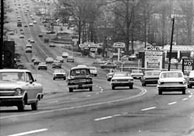Richmond Highway revitalizing, but many challenges remain
Revitalizing suburban highway corridors in the Washington area presents a challenge, with small parcels, uncooperative property owners, opposition from neighbors, outdated plans, auto-oriented zoning, and identity issues. Route 1 from the Beltway in Alexandria to Fort Belvoir, also known as Richmond Highway, shows the good and bad of revitalization.
For many people, Route 1 conjures up black and white photographs of big American cars, roadside motels, and drive-in movies. It may also bring to mind a less lofty vision, where you could visit a souvenir shop, a fortune teller, a greasy spoon diner, or maybe even a flea market.
The economy that created all of this development dried up more than 50 years ago when Interstate 95 was completed, diverting most of the through traffic away from Route 1. Yet, remarkably, even in a thriving metropolis like ours, the past traces of the former highway are still visible.
Along Baltimore Avenue in Prince George’s County, Rhode Island Avenue in Northeast DC, or Richmond Highway in Fairfax County, roadside motels, ramshackle retail buildings, and ancient diners still survive. Even Jefferson Davis Highway in Crystal City still bears some reminders of the motor age amidst its gleaming high rises.
As the executive director of the Southeast Fairfax Development Corporation (SFDC), my job is to promote revitalization along Richmond Highway, our eight-mile long segment of Route 1 from the Beltway to Fort Belvoir.
At first blush, revitalizing this area would seem to be a simple task. The area abuts Old Town, Fort Belvoir, and National Harbor, is quite affordable relative to other close-in areas, and is very convenient to Arlington and the District via Metro’s Yellow Line. From the Huntington Metro station, located at the north end of the corridor, it is just a 20 minute ride to L’Enfant Plaza.
All of these assets have begun to catch the attention of the development community in the past few years. Three major retail developers, Saul Centers, Federal Realty, and JBG Rosenfeld, have collectively invested more than $100 million into modernizing dated suburban shopping centers.
The area’s long-forgotten tourism industry is making a BRAC-related comeback, as Baywood Hotels and OTO Development have combined to open 4 new national-flag hotels with 364 rooms since 2009, with much of the demand coming from Fort Belvoir. Finally, and most importantly, the Richmond Highway corridor is drawing strong interest from developers of high density, mixed-use projects, especially near the Huntington Metro.
Recent projects like Kettler’s Midtown Alexandria Station and Home Properties’ Courts at Huntington Station have already added more than 800 units next to the Metro station. About a mile to the south, directly on Richmond Highway, Redbrick Partners is developing the 290-unit, mixed-use Beacon of Groveton that is set to open later this year. Looking ahead, more than 2,500 additional multi-family units are currently proposed by several other developers in the corridor.
And then there’s the hard part.
Though this task may seem fairly easy given the area’s many assets, any seasoned GGW reader knows well that revitalizing aging commercial areas is never easy, whether in urban or suburban settings. In addition to the common obstacles to revitalization identified above, several other factors make revitalization along Richmond Highway a challenge in spite of strong market demand:
- Significant portions of the corridor have environmental constraints like floodplain, wetlands, or poor soils that make development very expensive if not entirely impossible.
- Traffic congestion in the area, which was already severe, was worsened by the BRAC-directed employment growth at Fort Belvoir, the National Geospatial Intelligence Agency in Springfield, and Mark Center, none of which is located near Metrorail.
- Fairfax County is committing both its funding and planning resources to the Silver Line corridor, and is not likely to be willing to invest heavily in transit improvements along Richmond Highway anytime soon.
- Richmond Highway faces an enduring image as a lower-end, auto-oriented strip.
- It lacks a distinct identify, underscored by the fact that the area’s mailing address is Alexandria, but it is outside the city limits in unincorporated Fairfax County.
I plan to post occasional dispatches from Richmond Highway. If you haven’t been here for a while I encourage you to revisit the corridor to see how things are evolving, via car, bike, or bus—Metro’s Richmond Highway Express (REX) service is excellent. In the meantime, I’d love to hear from the Greater Greater Washington community with any ideas or cautionary tales on how to revitalize this area.

